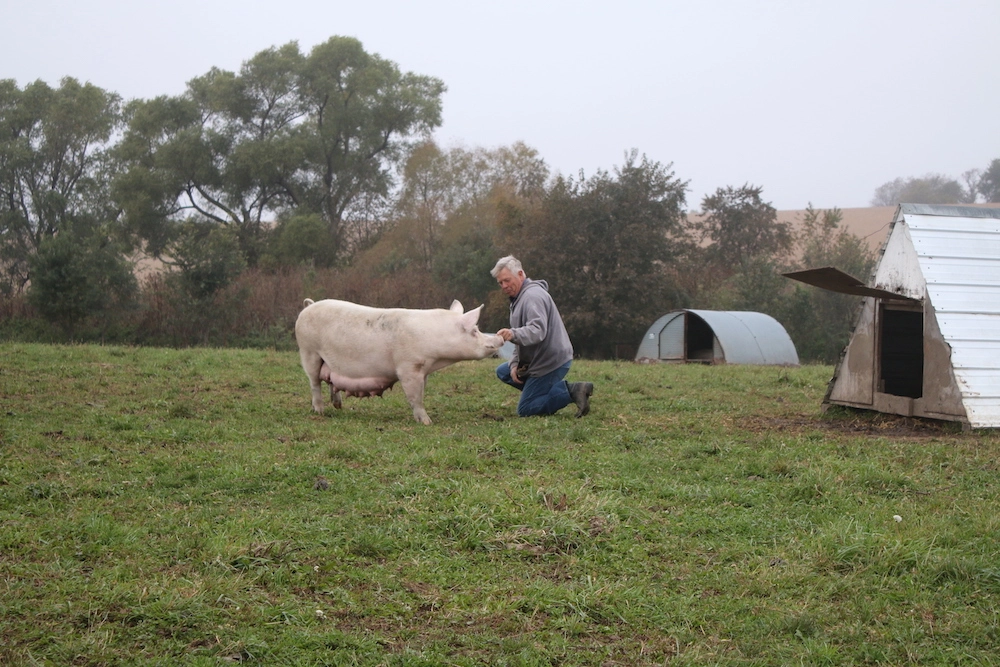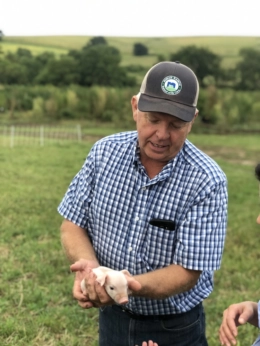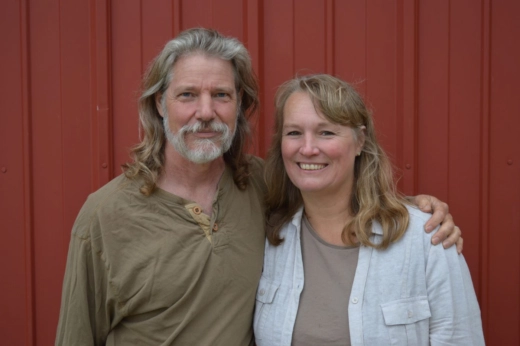As the sales of antibiotics for use in livestock increase, these farmers say they have a better way.

Nearly four decades ago, Ron Mardesen and his wife Denise stopped using antibiotics on their hog farm, A-Frame Acres, in Elliot, Iowa. He decided there was a better way to raise his animals, one that wouldn’t require the need for routine antibiotics. After prioritizing clean feed, fresh air, comfortable bedding and plenty of space, he says his pigs began to thrive. In 2002, Mardesen started selling his pork to Niman Ranch, a network of independent family farmers that raise livestock without antibiotics or added hormones.
As the owner of a multi-generational farm, Mardesen has seen industrial agriculture and factory farming take increasing control over meat production in the last few decades. With that has come the extreme overuse of antibiotics in livestock farming.
“You know, we want to produce more pounds of pork, more pounds of beef, more pounds of chicken on smaller and smaller resources. The best way they have come up with to continue with this efficiency push is to pound antibiotics,” says Mardesen. “I have never been comfortable taking an animal as intelligent as a pig and cramming them into a concrete box for the sake of efficiency.”
A recent report released by the US Food and Drug Administration (FDA) found that antibiotic sales for meat production increased by 4 percent from 2021 to 2022, with pigs and cattle accounting for the majority of sales. Antibiotic sales for animal use peaked in 2015, after which the FDA banned the use of antibiotics for animal growth, leading to a major decline in antibiotic sales the following year. But from 2017 onwards, antibiotic sales for livestock farming have steadily risen each year, increasing 12 percent from 2017 to 2022.
“I have never been comfortable taking an animal as intelligent as a pig and cramming them into a concrete box for the sake of efficiency.”
About 70 percent of medically important antibiotics in the US are sold for animals, not humans. The more an antibiotic is used, the more both animals and humans develop resistance to them, which significantly lowers the effectiveness of the intervention, says Steve Roach, food program director at Food Animal Concerns Trust (FACT), an organization that advocates for humane farming.
While antibiotics were originally used to treat sick animals, in the 1940s, farmers discovered regular antibiotic use could make animals grow faster in less time and with fewer resources.
Although the US banned the use of antibiotics for growth, they are still used for disease prevention and disease control. If one animal gets sick, the entire group is often treated because they live in such close proximity to one another.
Nearly a third of medically important antibiotics have no duration limit, meaning a farmer can use those antibiotics in feed for as long as they want to prevent disease. Roach says this allows farmers to keep animals in poor living conditions that are more likely to get them sick.

Ron Mardesen stopped the use of routine antibiotics nearly 40 years ago. (Photo courtesy of Ron Mardesen)
Antibiotic use is particularly common on factory farms, where certain practices lead to disease in animals. Cattle are often fed a corn or soy diet instead of grass, which can lead to illness. Baby pigs are weaned off their mother’s milk and fed solid foods before they’re ready, causing diarrhea.
“Having animals close together in crowded conditions, it saves you money, but also disease can easily spread,” says Roach. “You give them a diet that causes problems, so you basically just feed them antibiotics continuously.”
Lynn Utesch, a cattle farmer in Kewaunee County, Wisconsin—a region often referred to as CAFO alley for its high concentration of factory farms—discovered early on that, with the right methods, he doesn’t need antibiotics to raise his cattle. He and his wife Nancy own a 150-acre grass-fed beef farm and use a rotational grazing method. Every two days, they move their cows to a new pasture and the animals have plenty of space from one another. In his 30 years farming, Utesch has never had to use antibiotics on his cattle, not even for treatment.
“If you allow the animal to eat its natural diet, if you allow it to live the way that nature intended out in the open air and where it cannot be confined tightly to the other cows, then you don’t have any need for antibiotics because those animals are completely healthy,” says Utesch.

Lynn and Nancy Utesch. (Photo courtesy of Lynn Utesch)
When the Utesches started farming, their customers expressed a preference for antibiotic-free, grass-fed beef. It was hard to find that elsewhere at the time. These days, it’s what many consumers look for. A 2021 poll found that “antibiotic-free” labels are important to two-thirds of Americans when buying meat.
Despite this priority, labeling is far from straightforward. From “antibiotic-free” to “no antibiotics routinely used” to “antibiotics may be used,” there are plenty of ambiguities within labeling and there is little room for nuance, says Roach. Antibiotics were designed to treat sick animals, but the overuse and lack of transparency has led to “an all-or-nothing mindset” and negated their original intent, he says.
FACT supports antibiotic use for animal treatment, but only if it is approached with transparency and communication between the farmer and the certifier. The Antibiotic Resistance Action Center at George Washington University is developing a “certified responsible antibiotic use” label, which would allow antibiotics for treatment but not for prevention.
“When you do use antibiotics for treatment, you need to report that to the certifier and let them know. And so we kind of prefer that label, but it’s harder to communicate that to the consumer,” says Roach.
Unlike Utesch, Mardesen of A-Frame Acres does use antibiotics to treat a pig if it falls ill, but he uses a strict documentation process. He has to clearly identify the animal, what type of antibiotic was administered, the outcome of the treatment and where the animal was marketed. He cannot sell that pork to Niman Ranch, which has a strict “no-antibiotics ever” policy.
“If I do get an animal that does get sick, because I don’t routinely always throw antibiotics at these animals, when I have to treat an animal, the antibiotics that are available to use work a lot better on the farm,” says Mardesen.
Limiting antibiotic use will likely require stricter regulation from the FDA and more transparency in labeling. The USDA is considering implementing higher standards for meat to be labeled antibiotic free. But both Mardesen and Utesch say it starts with changing practices that benefit the animals so antibiotics aren’t needed for prevention or control. If there wasn’t such a focus on yield and production in the food system, fewer animals would be crammed into tight spaces and fed poor diets, says Utesch.
As a consumer, Utesch says the best thing you can do is educate yourself and learn where your food comes from. Look for organic and grass-fed meat, understand the different labels and, most of all, build a relationship with your local farmer.
“Find a farmer, and not only just pick up the product the farmer has, but have a relationship where you say, ‘What does rotational grazing mean? Or outdoor access? What does that mean to you?’ Have a conversation about how an animal is actually raised and handled,” says Nancy Utesch.


I don’t eat red meat or any pig meat, but I eat chicken and turkey; I’ll bet they get the antibiotics, too, and the cramped quarters (where the standards are “if a bird can raise its wings half-way, that’s free range,” free-range is disinformation intended for the ignorant, like the Trumpster and right to work. If the societal discourse is only various shades of disinformation in service to profit at any cost. Is it any wonder the 6th Mass Extinction is ignored?
HH